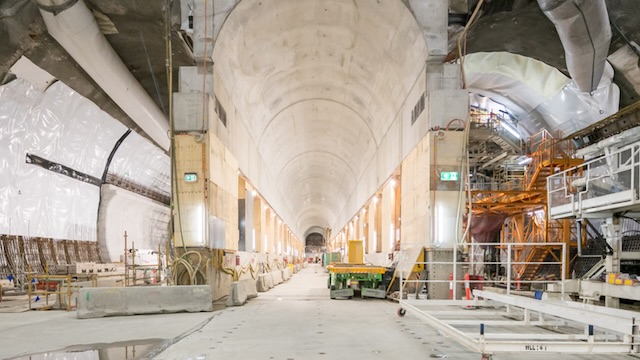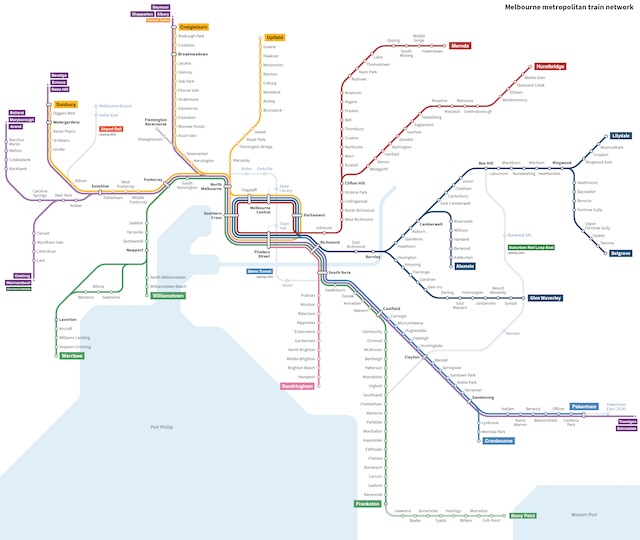American cities are not the only ones building insane rail projects. Melbourne, Australia’s largest city, is currently building a 56-mile (90-kilometer) suburban rail line. Once projected to cost AU$50 billion (about US$32 billion), the projected costs have risen to AU$125 billion (about US$79 billion). Although construction has already begun, the city doesn’t expect to complete all 90 kilometers for 25 years, by which time the costs will probably have risen much higher.
The Melbourne Suburban Loop under construction. Photo by Rail Projects Victoria.
At the present projected cost, that’s more than $1.4 billion per mile in U.S. dollars, making it the most expensive (in dollars per mile) transit project in the world outside of New York City. One reason for the high cost is that it will all be underground, but plenty of other cities (other than New York) have been able to build subways for less than $1.4 billion a mile, and most of them much less than $1.0 billion a mile.
Compounding this high cost, the trains will have low capacities. Melbourne’s existing subway uses six- to seven-car trains capable of carrying around 1,200 to nearly 1,400 people per train. But platforms for the new subway that is under construction will only be long enough for four-car trains, thus limiting the number of passengers to less than 800. In other words, this is what I call a high-cost, low-capacity transit system.
Existing subway lines are shown in color; the 90-km suburban lines under construction are shown as blue dotted lines. Map by Gracchus250. Click image for a larger view.
In addition to more than 250 miles of subway lines, Melbourne also has the world’s largest streetcar system, with more than 155 miles of double-track lines. Yet only about 3 percent of Melbourne commuters take rail transit to work, which should give pause to anyone who thinks that U.S. cities can get people out of their cars by building more rail lines. Melbourne planners argue this low rate of rail usage is because all of the rail lines feed into downtown, meaning they don’t serve the vast majority of commuters who don’t work downtown. The suburban subways are supposed to fix that.
It’s not going to work. As the above map shows, the 90 kilometers connect a handful of suburbs with other suburbs. Despite the name “Suburban Loop,” the line doesn’t make a full loop and actually goes downtown. That means someone wanting to go by train from, say, Pakenham to Hurstbridge or Mernda to Craigieburn is still going to have to go downtown, taking them well out of their way. Melbourne would have to build well over a thousand kilometers of rail lines to connect every suburb with every other suburb.
Why bother when the region already has infrastructure connecting every part with every other part? Buses on roads make far more sense than rail transit because buses are flexible, inexpensive, and if need be can safely operate far more frequently than trains. Bus routes can instantly be adjusted in response to changing traffic patterns, while Melbourne is planning to spend the next 25 years building a rail line when no one knows if anyone will want to ride trains in 2048.
Melbourne never should have embarked on this horrendous rail folly. Now that it has started, it should finish whatever tunnels have been dug and build no more. Instead, it should put its efforts into figuring out how to redesign its bus system to serve more people than just those going to or from downtown.










Australian rail ridership is not all different than US.
It’s just their shit is in better shape as it was built recently.
It’s Not Legacy 50-100 year old obsolete junk.
If the US/State governments wanna fund transportation revolution Skip the Megaprojects.
Install One Billion Bollard nationwide, Amortized cost, it’ll cost 150-260 billion dollars.
https://pbs.twimg.com/media/FuFUr6eWAAAtGZK?format=png&name=small
But will save Probably Half US pedestrian fatalities
and …. fuck cars up so bad, people will think twice about speeding. https://www.saferoads.com.au/media/product-gallery/omnistop-super-duty-1.jpg
eb. 6, a Chicago-area man received a record-breaking $91 million settlement from 7-Eleven after losing both his legs in an accidental crash outside one of the company’s stores in Bensenville, Illinois. a driver attempting to park stepped on the gas instead of the brake, leaving the plaintiff pinned between the store building and the car and in need of a double amputation – revealed that these types of incidents occur with troubling frequency – with 6,253 cars crashing into U.S. 7-Eleven storefronts over a 15-year period.
I don’t understand Why 7/11 had to pay, why are they culpable.
meanwhile in China:
https://twitter.com/i/status/1714706912321958299
Of course, high speed rail in China is hemorrhaging funds and is one of a number of financial boondoggles that threaten the future of China. Not something to worry about as long as it provides good videos, I guess.
Also China….
– Trillion in debt from this project alone
– Poor quality construction
– numerous derailments
– empty trains
https://www.youtube.com/watch?v=jQ5tKr_y4BA
Yeah that train station looked pretty empty except for all the people entering and exiting the trains.